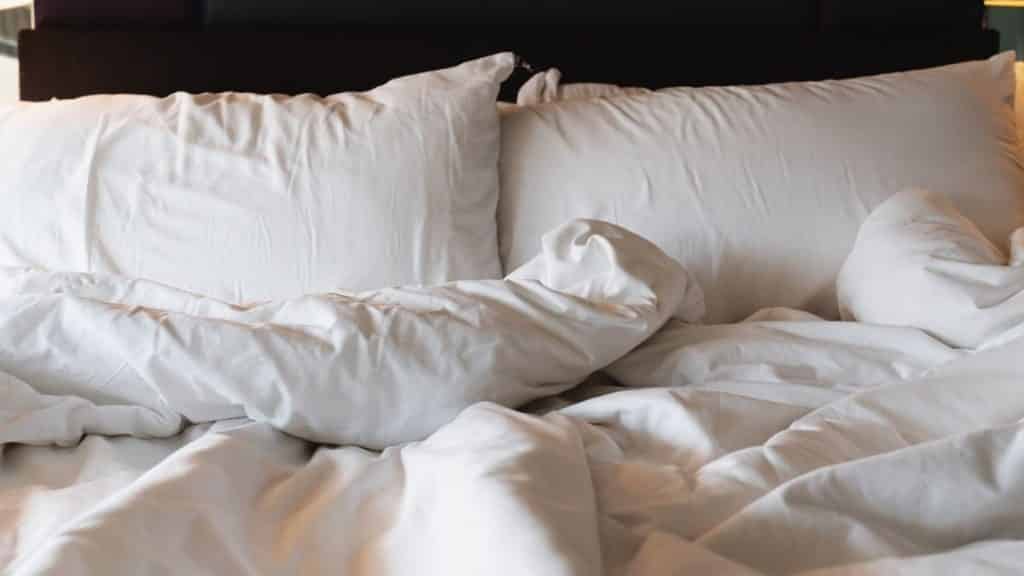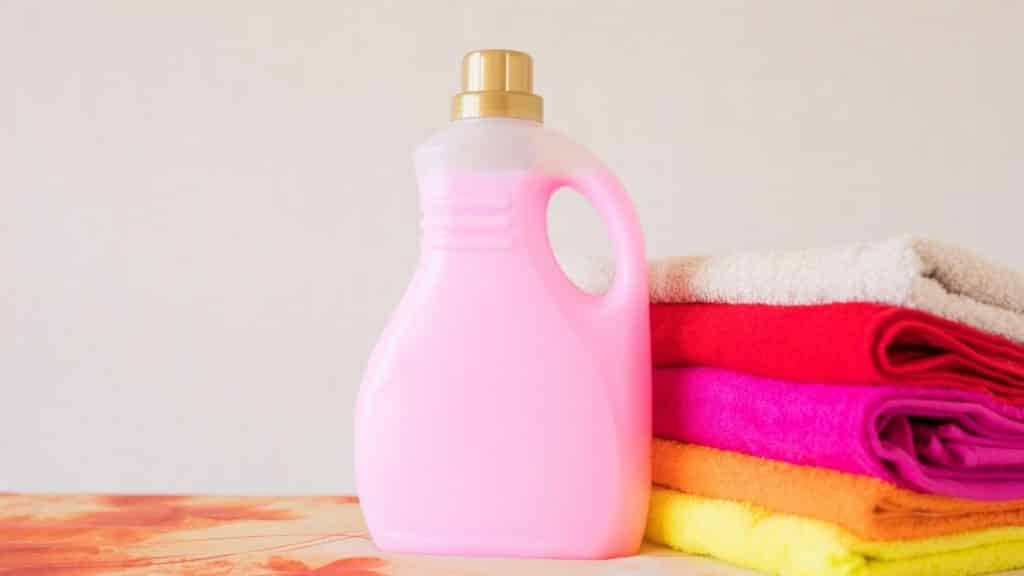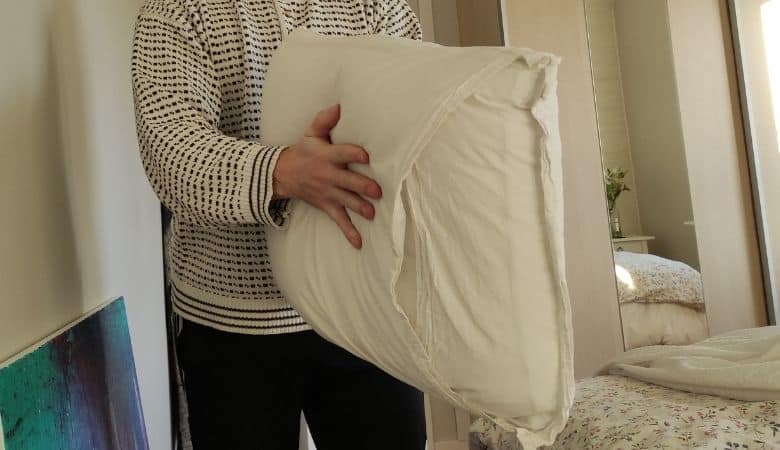A down pillow is filled with the soft undercoating, most commonly plucked, from geese and ducks. These pillows are suitable for all sleeping positions, but they are not suitable for people who suffer from chronic neck pain. Since they allow enough room for airflow, down pillows also tend to sleep fairly cool.
But, why are they so hard in the beginning? Will they soften over time?
A down pillow will break in and become softer with time. The extent of softness depends on how you use and maintain your pillow (some people use the pillow as a punching bag as others are more gentle), and so on.
Follow our guide to learn about why pillows get softer over time and how to soften them yourself.
Why is my Down Pillow Hard?

At first, new pillows, mainly down pillows, may seem hard. Fibers haven’t been manipulated enough to soften for new pillows, so they need to be warmed or crushed to soften and make them comfortable to sleep on.
The fibers acclimatize to the weight of your head and soften over time. You can use various procedures to reduce some stiffness from new pillows until then.
How to Soften Down Pillows
If you don’t want to give your down pillows time to soften, you can employ various methods as soon as you buy them. Below are easy ways you can use to achieve this.
Step 1
Insert the pillow inside the pillowcase, and on one side of the pillow, stuff batting or any other soft filling into the pillowcase. To avoid huge clumps, distribute the material evenly. Fill the pillowcase with enough filling to properly soften the pillow.
Step 2
Adjust the temperature of a heating pad to medium. Place the pad on top of the hard pillow. Give the heating pad 15 minutes to soften the pillow adequately.
Step 3
Lay the hard pillow below an electric blanket. Before retiring to bed, turn on the blanket for 10 to 15 minutes to allow the blanket to soften the pillow.
Step 4
Place the hard pillow on a hard surface. Use a broom handle or rug beater to beat the pillow. The clubbing weakens and relaxes the hard pillow fibers.
Can You Use Fabric Softener on Down Pillows?

Pillows frequently become lumpy when the fill material clumps together as a result of frequent use. If fluffing the pillow in the dryer does not restore its original shape, you may be required to use a fabric softener.
Fabric softener softens your bedding and clothing, preventing wrinkles and wear and tear on the fabric. It also helps to remove static electricity. However, you may be wondering if fabric softener is safe to use on pillows.
Pillows should not be treated with fabric softeners. Oils and polymers in liquid fabric softeners can cause the fill material to clump. The oils may also stick to the outside of the pillow, attracting additional oil and dirt.
Using a fabric softener may cause your pillow to deteriorate. Instead of fluffy, the softener may leave your pillow clumpy, matted, and more vulnerable to mildew and bacteria.
Why is my Down Pillow Flat?
The main cause of a flat pillow is compression. Because of your head or body weight, the fill material becomes compressed.
Another cause of flat pillows is moisture. Moisture causes the fill material to flatten and clump as it weighs it down. Mold spores thrive in moist environments, such as those found in pillows.
Dead skin cells, mold, dust mites, hair, and body oils can all weigh down a pillow and cause it to lose its fluffiness. Dead dust mites open in a new tab, and their coverings make up about 10% of the weight of your pillow.
Pillows may become flat when the filling material breaks down and degrades. The absorbency of down feathers, cotton filling, polyester fiberfill, and other soft fill materials degrade. The fill material stiffens and clumps easily rather than absorbing some moisture in the pillow.
How to Fluff a Down Pillow

Nothing beats sinking your head into a fluffy down pillow at the end of a busy day. Down pillows are extremely luxurious, but their comfort level can reduce significantly if not properly taken care of.
There are a few simple methods and steps you can take to prevent your bed pillows from flattening, breeding allergens, or becoming lumpy. Learn how to fluff down pillows and get ready to sleep like a baby!
Method 1: Fluffing Pillows by Hand
Step 1
Hold the tip of each pillow with your hands. Push the pillow’s ends in and out. Continue in the same manner you would use to squeezebox or piano accordion, but a bit fast.
The pillow can then be reshaped with your hands to fit properly on the bed or into the pillowcases. Pillows that have been fluffed up improve the overall appearance of your bedroom. They will also make you more comfortable and help in your sleep.
However, before sleeping on or fluffing up pillows containing feathers or down, make sure you are not allergic to them. Feather and down allergy is fairly common, particularly in people with asthma or other lung complications.
Step 2
Strike the pillows. If your pillows are not too moist, fluff them by hitting the sides with your fists at the same time.
Because feather pillows have the lightest fill material, they are the easiest to fluff. Just hitting a feather pillow lightly should do the trick.
Take your pillow and whack it a few times on your bed to even it out.
Step 3
Squeeze the pillows together. Grab the pillow at the top. Ensure your pillow goes up and down, not side to side like when you sleep.
Move your hands to the center of the pillow, if possible, a little above it. Now squeeze it quickly, release it, and hold the pillow.
Repeat this five times. Once you are done, shake them vigorously, place them back on your bed, and then beat the pillow with your flat hand on all sides.
Method 2: Drying Pillows to Fluff Them
Step 1
Place the pillows in the dryer. You can put the pillows with something like a tennis ball in the dryer. Running the pillow through the dryer will fluff it up. Once a month, you can put your pillows in the dryer.
Place the tennis ball in a sock, tie the ends of the sock, and put them in the dryer for some minutes.
Step 2
Allow the pillow to dry in the sun. Pillows typically lose volume due to moisture, so the sun will dry them and increase fluffiness.
If fluffing pillows by hand does not work, place the pillow in the sun for a number of hours. If you have a clothesline outside, you can hang the pillows to dry fast.
Four hours are enough for the sun to absorb the moisture.
Method 3: Knowing When to Replace Pillows
Step 1
Fluff your pillows often to maintain their shape. By doing this, the air is free to circulate and prevent them from becoming permanently deflated. You will not have to replace them as frequently.
You should also wash your pillowcases on a regular basis. Who wants to sleep with a dirty pillowcase? It’s a good idea to wash your pillowcases once a week.
Step 2
After a few years, you should replace your pillow. Some pillows cannot be restored completely and need replacement.
According to experts, pillows should be replaced after 3-5 years, mainly to get rid of dust mites. Lay your pillow down on a flat surface. It’s probably time to replace it if it has lumps, dents, or bumps. If you wake up with a painful neck, it’s because the pillow is not providing enough support.
Perhaps you won’t be able to restore your pillows to their normal fluffiness once they’ve been frequently crushed and the stuffing has flattened because of moisture from your sweat. Replace the pillow if it emits a mildew odor. Fold your pillow in half and check if it will return into place. If it does not, then replace it.
